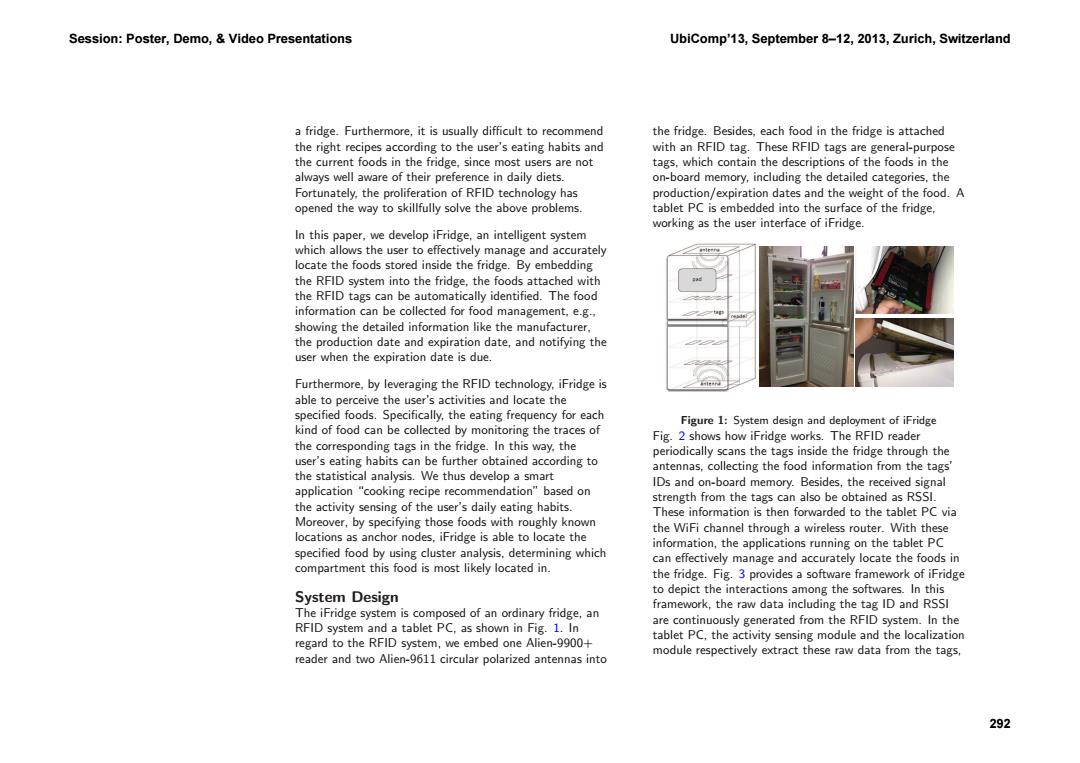正在加载图片...

Session:Poster,Demo,Video Presentations UbiComp'13,September 8-12,2013,Zurich,Switzerland a fridge.Furthermore,it is usually difficult to recommend the fridge.Besides,each food in the fridge is attached the right recipes according to the user's eating habits and with an RFID tag.These RFID tags are general-purpose the current foods in the fridge,since most users are not tags,which contain the descriptions of the foods in the always well aware of their preference in daily diets. on-board memory,including the detailed categories,the Fortunately,the proliferation of RFID technology has production/expiration dates and the weight of the food.A opened the way to skillfully solve the above problems. tablet PC is embedded into the surface of the fridge, working as the user interface of iFridge. In this paper,we develop iFridge,an intelligent system which allows the user to effectively manage and accurately locate the foods stored inside the fridge.By embedding the RFID system into the fridge,the foods attached with the RFID tags can be automatically identified.The food information can be collected for food management,e.g.. showing the detailed information like the manufacturer. the production date and expiration date,and notifying the user when the expiration date is due. Furthermore,by leveraging the RFID technology,iFridge is able to perceive the user's activities and locate the specified foods.Specifically,the eating frequency for each Figure 1:System design and deployment of iFridge kind of food can be collected by monitoring the traces of Fig.2 shows how iFridge works.The RFID reader the corresponding tags in the fridge.In this way.the periodically scans the tags inside the fridge through the user's eating habits can be further obtained according to antennas,collecting the food information from the tags the statistical analysis.We thus develop a smart application "cooking recipe recommendation"based on IDs and on-board memory.Besides,the received signal strength from the tags can also be obtained as RSSI. the activity sensing of the user's daily eating habits. These information is then forwarded to the tablet PC via Moreover,by specifying those foods with roughly known the WiFi channel through a wireless router.With these locations as anchor nodes,iFridge is able to locate the information,the applications running on the tablet PC specified food by using cluster analysis,determining which can effectively manage and accurately locate the foods in compartment this food is most likely located in. the fridge.Fig.3 provides a software framework of iFridge System Design to depict the interactions among the softwares.In this framework,the raw data including the tag ID and RSSI The iFridge system is composed of an ordinary fridge,an RFID system and a tablet PC,as shown in Fig.1.In are continuously generated from the RFID system.In the regard to the RFID system,we embed one Alien-9900+ tablet PC,the activity sensing module and the localization module respectively extract these raw data from the tags, reader and two Alien-9611 circular polarized antennas into 292a fridge. Furthermore, it is usually difficult to recommend the right recipes according to the user’s eating habits and the current foods in the fridge, since most users are not always well aware of their preference in daily diets. Fortunately, the proliferation of RFID technology has opened the way to skillfully solve the above problems. In this paper, we develop iFridge, an intelligent system which allows the user to effectively manage and accurately locate the foods stored inside the fridge. By embedding the RFID system into the fridge, the foods attached with the RFID tags can be automatically identified. The food information can be collected for food management, e.g., showing the detailed information like the manufacturer, the production date and expiration date, and notifying the user when the expiration date is due. Furthermore, by leveraging the RFID technology, iFridge is able to perceive the user’s activities and locate the specified foods. Specifically, the eating frequency for each kind of food can be collected by monitoring the traces of the corresponding tags in the fridge. In this way, the user’s eating habits can be further obtained according to the statistical analysis. We thus develop a smart application “cooking recipe recommendation” based on the activity sensing of the user’s daily eating habits. Moreover, by specifying those foods with roughly known locations as anchor nodes, iFridge is able to locate the specified food by using cluster analysis, determining which compartment this food is most likely located in. System Design The iFridge system is composed of an ordinary fridge, an RFID system and a tablet PC, as shown in Fig. 1. In regard to the RFID system, we embed one Alien-9900+ reader and two Alien-9611 circular polarized antennas into the fridge. Besides, each food in the fridge is attached with an RFID tag. These RFID tags are general-purpose tags, which contain the descriptions of the foods in the on-board memory, including the detailed categories, the production/expiration dates and the weight of the food. A tablet PC is embedded into the surface of the fridge, working as the user interface of iFridge. Figure 1: System design and deployment of iFridge Fig. 2 shows how iFridge works. The RFID reader periodically scans the tags inside the fridge through the antennas, collecting the food information from the tags’ IDs and on-board memory. Besides, the received signal strength from the tags can also be obtained as RSSI. These information is then forwarded to the tablet PC via the WiFi channel through a wireless router. With these information, the applications running on the tablet PC can effectively manage and accurately locate the foods in the fridge. Fig. 3 provides a software framework of iFridge to depict the interactions among the softwares. In this framework, the raw data including the tag ID and RSSI are continuously generated from the RFID system. In the tablet PC, the activity sensing module and the localization module respectively extract these raw data from the tags, Session: Poster, Demo, & Video Presentations UbiComp’13, September 8–12, 2013, Zurich, Switzerland 292